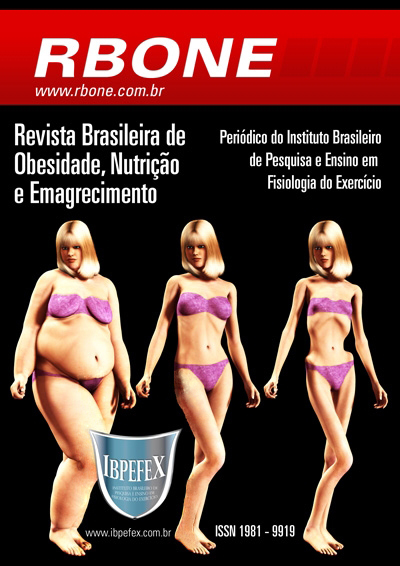Nutritional status, eating habits and perception of quality of life of university students of a Public University of the South of Minas Gerais
Abstract
Introduction: The assessment of nutritional status is directly related to quality of life. Objective: to evaluate the nutritional status, eating habits and perception of quality of life of university students. Materials and methods: Cross-sectional study, with university students enrolled in health and human sciences and letters courses, of both sexes. For the assessment of eating habits, the questionnaire of the Surveillance System for Risk and Protection Factors for Chronic Diseases by Telephone Survey (VIGITEL) was used. To analyze the perception of quality of life, the SF-36 questionnaire was used. Weight, height, waist circumference and hip circumference were measured. Results: It was observed that the majority of university students did not have health problems, with 26.0% (n=26) being underweight and 27.0% (n=27) being overweight. Regarding the perception of health status, in relation to a year ago, 33.0% (n=33) did not observe changes, however 29.0% (n=29) reported being in worse health. Regarding the consumption of meat with visible fat, there was a positive correlation between nutritional status and consumption of chicken with skin by university students in the health area (r=0.515; p<0.01). Conclusion: Most university students had inadequate nutritional status. In addition, contrary to what was expected, university students in the health field, at first with greater knowledge of healthy living practices, did not show better eating habits than university students in the humanities and letters area.
References
-Alves, H.J.; Boog, M.C.F. Comportamento alimentar em moradia estudantil: um espaço para a promoção da saúde. Revista de Saúde Pública. Vol. 41. Num. 2. 2007. p. 197-204.
-Brasil. Ministério da Saúde. Secretaria de Vigilância em Saúde. Departamento de Análise em Saúde e Vigilância de Doenças Não Transmissíveis. VIGITEL Brasil 2019: vigilância de fatores de risco e proteção para doenças crônicas por inquérito telefônico: estimativas sobre frequência e distribuição sociodemográfica de fatores de risco e proteção para doenças crônicas nas capitais dos 26 estados brasileiros e no Distrito Federal em 2019. Brasília. 2020.
-Busato, M.A.; Pedrolo, C.; Gallina, L.S.; Rosa, L. Ambiente e alimentação saudável: percepções e práticas de estudantes universitários. Semina: Ciências Biológicas e da Saúde. Londrina. Vol. 36. Num. 2. 2015. p. 75-84.
-Faria, J.T. Guia de Antropometria: medidas, indicadores e protocolos. 2ª edição. 2011.
-Fernandes, I.I.B.; Vasconcelos, K.C.; Silva, L.L.L. Análise da qualidade de vida segundo o questionário SF-36 nos funcionários da gerência de assistência nutricional (GAN) da fundação Santa Casa de Misericórdia do Pará. TCC. Centro de Ciências Biológicas e da Saúde da Universidade da Amazônia. Belém. 2009.
-Manzatto, L.; Rocha, T.B.X.; Júnior, G.B.V.; Lopes, G.M.; Souza, J.A. Consumo de álcool e qualidade de vida em estudantes universitários. Conexões: revista da Faculdade de Educação Física da UNICAMP. Vol. 9. Num. 1. 2011. p. 37-53.
-Marcondelli, P.; Costa, T.H.M.; Schmitz, B.A.S. Nível de atividade física e hábitos alimentares de universitários do 3º ao 5º semestre da área da saúde. Revista de Nutrição. Vol. 21. Num. 1. 2008. p. 39-47.
-Miranda, A.S.; Castro, J.S.; Santana, R.F. Perfil nutricional e alimentar de universitárias do Sudoeste da Bahia. Uniciências. Vol. 20. Num. 1. 2016. p. 39-43.
-Monteiro, M.R.P.; Andrade, M.L.O.; Zanirati, V.F.; Silva, R.R. Hábito e consumo alimentar de estudantes do sexo feminino dos cursos de nutrição e de enfermagem de uma Universidade Pública Brasileira. Revista de APS. Vol. 12. Num. 3. 2009. p. 271-277.
-Organización Mundial de la Salud. El estado físico: uso e interpretación de la antropometría: Informe de un Comité de Expertos de la OMS. Ginebra. 1995.
-Paixão, L.A.; Dias, R.M.R.; Prado, W.L. Estilo de vida e estado nutricional de universitários ingressantes em cursos da área de saúde do Recife-PE. Revista Brasileira de Atividade Física & Saúde. Vol. 15. Num. 3. 2010. p. 145-150.
-Petribú, M.M.V.; Cabral, P.C.; Arruda, I.K.G. Estado nutricional, consumo alimentar e risco cardiovascular: um estudo em universitários. Revista de Nutrição. Vol. 22. Num. 6. 2009. p. 837-846.
-Pinheiro, A.R.O.; Freitas, S.F.T.; Corso, A.C.T. Uma abordagem epidemiológica da obesidade. Revista de Nutrição. Vol. 17. Num. 4. 2004. p. 523-533.
-Pitanga, F.J.G.; Lessa, I. Razão cintura-estatura como discriminador do risco coronariano de adultos. Revista da Associação Médica Brasileira. Vol. 52. Num. 3. 2006. p.157-161.
-Silva, D.A.S. Indicadores do estilo de vida e autoavaliação negativa de saúde em universitários de uma instituição pública do nordeste do Brasil. Revista Brasileira de Atividade Física & Saúde. Vol. 17. Num. 4. 2012. p.263-269.
-Silva, L.A.; Moreira, E.M.S. Avaliação dos hábitos alimentares de estudantes do curso de Nutrição do Centro Universitário de Patos de Minas (UNIPAM). Perquirere. Vol. 8. Num. 2. 2011. p.30-45.
-Veiga, C.; Cantorani, J.R.H.; Vargas, L.M. Qualidade de vida e alcoolismo: um estudo em acadêmicos de licenciatura em educação física. Conexões. Vol. 14. Num. 1. 2016. p. 20-34.
-World Health Organization. Obesity: Preventing and managing the global epidemic. Report of a WHO Consulation on Obesity. Geneva. 1998.
Copyright (c) 2022 Hylly Fonseca Bertrand Miranda, Fernanda de Carvalho Vidigal

This work is licensed under a Creative Commons Attribution-NonCommercial 4.0 International License.
Authors who publish in this journal agree to the following terms:
- Authors retain the copyright and grant the journal the right of first publication, with work simultaneously licensed under the Creative Commons Attribution License BY-NC which allows the sharing of the work with acknowledgment of the authorship of the work and initial publication in this journal.
- Authors are authorized to enter into additional contracts separately for non-exclusive distribution of the version of the work published in this journal (eg, publishing in institutional repository or book chapter), with acknowledgment of authorship and initial publication in this journal.
- Authors are allowed and encouraged to post and distribute their work online (eg, in institutional repositories or on their personal page) at any point before or during the editorial process, as this can bring about productive change as well as increase impact and impact. citation of published work (See The Effect of Free Access).






